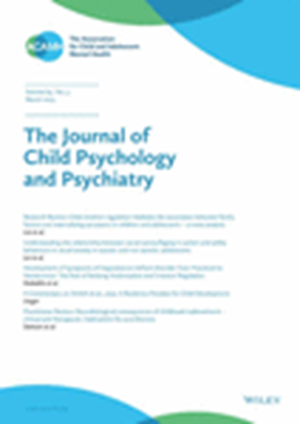5 个月大时的亲子互动:遗传和环境因素以及与日后社会交流发展的关系
IF 6.5
1区 医学
Q1 PSYCHIATRY
引用次数: 0
摘要
背景生命早期亲子互动(PCI)的特征与儿童日后的发展有关。双胞胎研究有助于区分儿童对亲子互动的贡献,例如,通过评估儿童的遗传对其社会环境(包括父母的行为)的影响。方法对来自社区样本的婴儿双胞胎[354对单卵(MZ),268对同性双卵(DZ)]进行了5个月大时的PCI评估。我们采用经典的双生子设计,绘制了父母和子女 PCI 量表的病因及其共变关系图。我们研究了PCI与父母后来评定的孩子在2岁和3岁时的社会交往、语言和自闭症特征之间的关系。独特的(非共享的)环境影响因素在多个 PCI 量表中大量重叠,这表明与每个阶段相关的特质以一种系统的方式影响着多个特质的评分。因子分析揭示了三个不相关的潜在因子,它们被概念化为 "儿童负面情绪"、"积极情绪互动 "和 "父母的支持策略"。在 5 个月大时 "敏感反应性 "评分较高的父母,其子女在第二年和第三年的社会交流和语言发展方面的评分往往较高,而自闭症特征方面的评分则较低。我们没有发现任何强有力的证据表明父母的行为会产生所谓的诱发遗传效应。我们在讨论这些结果时,考虑到了基于实验室观察的 PCI 测量在捕捉亲子互动的丰富性方面所面临的普遍挑战。本文章由计算机程序翻译,如有差异,请以英文原文为准。
Parent‐child interaction at age 5 months: genetic and environmental contributions and associations with later socio‐communicative development
BackgroundCharacteristics of parent‐child interaction (PCI) early in life have been associated with later development in the child. Twin studies can help to disentangle child contributions to parent‐child interaction, for example, by assessing the influence of the child's genetics on his/her social environment, which includes parental behaviour.MethodsInfant twins from a community sample [354 monozygotic (MZ), 268 same‐sex dizygotic (DZ)] were assessed in terms of PCI at age 5 months. We used the classical twin design to map the aetiology of several parent and child PCI scales and their covariation. We investigated the relations between PCI and later parent‐rated child's social communication, language, and autistic traits at ages 2 and 3.ResultsHeritability was below 20% for all the included PCI traits. Unique (nonshared) environmental influences substantially overlapped across several PCI scales, suggesting that idiosyncrasies linked to each session shaped the scoring of several traits in a systematic way. Factor analysis revealed three uncorrelated latent factors, which were conceptualized as ‘child negative affect’, ‘positive affective interaction’, and ‘parent's supportive strategies’. Parents who were rated highly on ‘sensitive responsiveness’ at 5 months tended to rate their offspring higher in terms of socio‐communicative and language development and lower in terms of autistic traits in the second and third years of life.ConclusionsThis study maps the phenotypic and aetiological structure of PCI in early infancy and supports the view that parents' sensitive responsiveness towards their infant is associated with later developmental gains in several domains. We did not find strong evidence of any so‐called evocative genetic effects on parents’ behaviour. We discuss the results considering the general challenge for lab‐based observational PCI measures to capture the richness of parent‐child interaction.
求助全文
通过发布文献求助,成功后即可免费获取论文全文。
去求助
来源期刊
CiteScore
13.80
自引率
5.30%
发文量
169
审稿时长
1 months
期刊介绍:
The Journal of Child Psychology and Psychiatry (JCPP) is a highly regarded international publication that focuses on the fields of child and adolescent psychology and psychiatry. It is recognized for publishing top-tier, clinically relevant research across various disciplines related to these areas. JCPP has a broad global readership and covers a diverse range of topics, including:
Epidemiology: Studies on the prevalence and distribution of mental health issues in children and adolescents.
Diagnosis: Research on the identification and classification of childhood disorders.
Treatments: Psychotherapeutic and psychopharmacological interventions for child and adolescent mental health.
Behavior and Cognition: Studies on the behavioral and cognitive aspects of childhood disorders.
Neuroscience and Neurobiology: Research on the neural and biological underpinnings of child mental health.
Genetics: Genetic factors contributing to the development of childhood disorders.
JCPP serves as a platform for integrating empirical research, clinical studies, and high-quality reviews from diverse perspectives, theoretical viewpoints, and disciplines. This interdisciplinary approach is a key feature of the journal, as it fosters a comprehensive understanding of child and adolescent mental health.
The Journal of Child Psychology and Psychiatry is published 12 times a year and is affiliated with the Association for Child and Adolescent Mental Health (ACAMH), which supports the journal's mission to advance knowledge and practice in the field of child and adolescent mental health.

 求助内容:
求助内容: 应助结果提醒方式:
应助结果提醒方式:


